Remember the kimchi we made last month? If you still have that last jar sitting around and notice that it’s starting to get pretty ripe (as in overly fermented), here’s an easy peasy recipe to put the rest of that kimchi to use.
In fact, I love to make extra jars of kimchi just for this reason! I’ll stash a jar in the back of the fridge, forget about it for a month, and then one day when I’m famished and digging through the kitchen, I’ll spot the long-forgotten jar and have an a-ha! moment.

Kimchi jjigae is my go-to meal when I’m feeling lazy but want a substantial dinner. Jjigae is Korean for stew, and it’s a common Korean comfort dish that’s served in most restaurants. But homemade kimchi jjigae is much better than what you’ll find eating out, because it’s not as salty and you can mix it up however you’d like. Sometimes I’ll add mushrooms (enoki is a favorite) and sometimes I’ll add extra spice with chiles. But the basic recipe is a one-pot wonder that just requires you to give a stir every so often, and you can go about your business while it simmers on the stove.
The stew gets thicker and tastier the longer you let it simmer, so I let mine cook for an hour (though it could be done in less time if you’re too hungry to wait!). It’s even better reheated the next day.
One thing to keep in mind is that gochujang is not simply the paste version of gochugaru (the red pepper powder you used to make kimchi). They are not interchangeable. Gochujang is a paste made from red pepper powder, fermented soybeans, and glutinous rice. It has a sweeter flavor than gochugaru coming from the soybeans, and makes a delicious marinade or sauce. In kimchi jjigae, it helps to thicken the stew and flavor the broth.
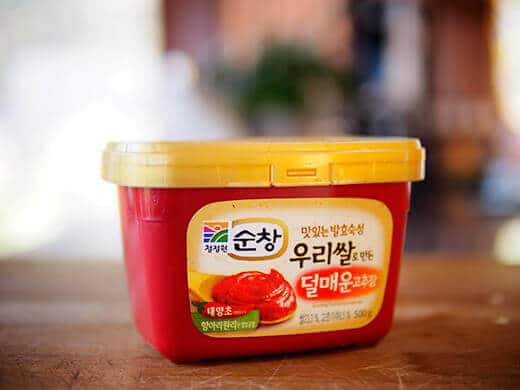
You could also add gochugaru to the stew if you’d like, but I find that there’s plenty of spice from the gochugaru already in the kimchi. Pour in all of that kimchi juice for an extra kick!
Kimchi Jjigae
Makes 4 servings
Ingredients
1/2 tablespoon sesame oil
1 pound pork belly (or pork shoulder), cubed
3 cups overly sour kimchi with juice
1/2 onion, sliced
4 green onions, sliced
4 cups water
1 tablespoon gochujang (Korean red pepper paste)
1/2 tablespoon sugar
1 tablespoon fish sauce
8 ounces medium or firm tofu
4 eggs
Sliced green onions (optional, for garnish)
Toasted sesame seeds (optional, for garnish)
Making Your Kimchi Jjigae
In a large pot over high heat, combine all the ingredients (except the tofu, eggs, and garnishes) and bring to a boil. (Quick tip: Use the mason jar to measure out 4 cups of water after emptying the kimchi.)
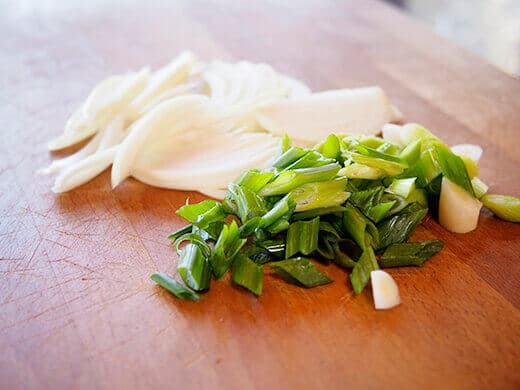
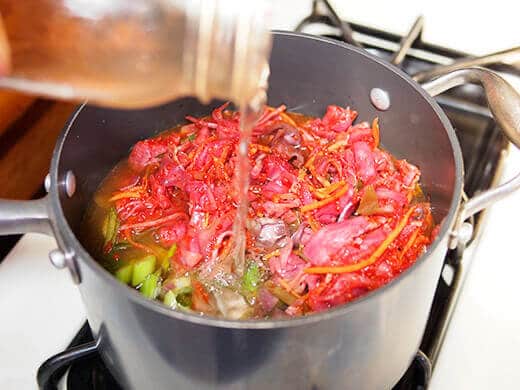
Once boiling, reduce the heat to medium and cover, leaving the lid slightly ajar. Simmer for 45 minutes.
Give a stir every so often. The stew should thicken up nicely and the pork should be so tender that it pulls apart easily. This is meant to be a stew, but if you like yours a bit soupy, feel free to add more water.
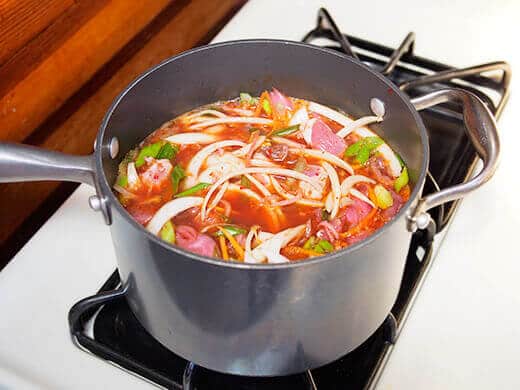
Use a large spoon to scoop irregular chunks of tofu from the package (8 ounces is approximately half the package, though you can use more or less). Since this is a lazy stew, it’s my lazy way of adding the tofu without cubing it. I also like how rustic it looks.
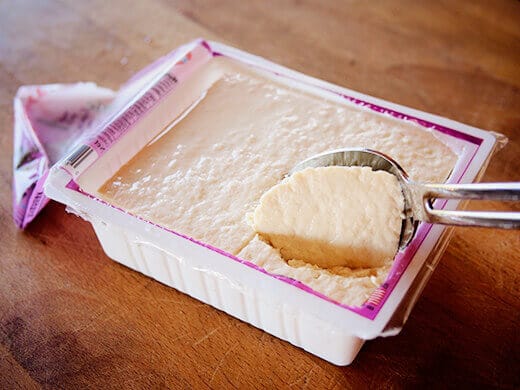
Into the pot goes the tofu. Crack the eggs into the stew, re-cover (leaving the lid ajar) and simmer for another 15 minutes. You don’t need to stir the eggs into the stew as this will scramble them; just let them poach until the whites are set.
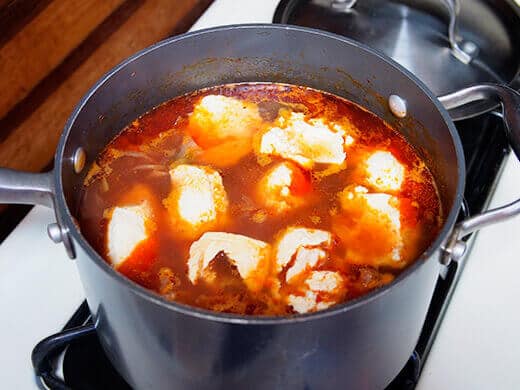
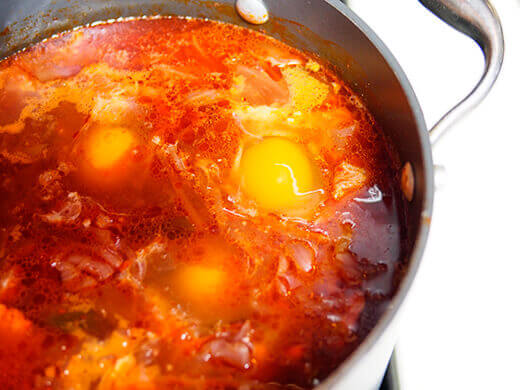
Divide the eggs evenly among your bowls and serve the stew over a bed of rice. Garnish with sliced green onions and sesame seeds… they do make it better!
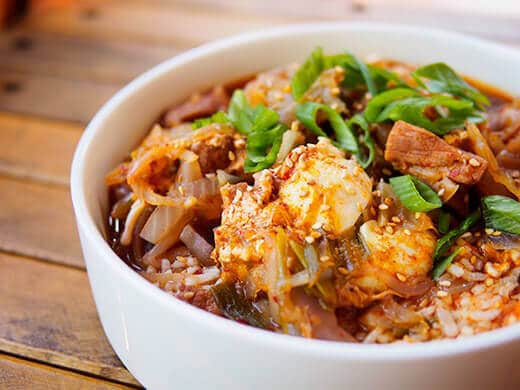
Kimchi Jjigae
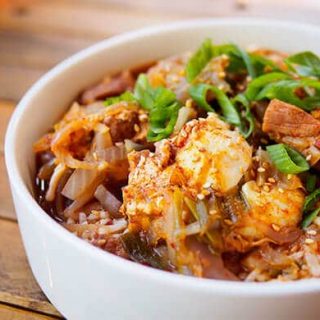
If you still have that last jar sitting around and notice that it’s starting to get pretty ripe (as in overly fermented), here’s an easy peasy recipe to put the rest of that kimchi to use.
Ingredients
- 1/2 tablespoon sesame oil
- 1 pound pork belly (or pork shoulder), cubed
- 3 cups overly sour kimchi with juice
- 1/2 onion, sliced
- 4 green onions, sliced
- 4 cups water
- 1 tablespoon gochujang (Korean red pepper paste)
- 1/2 tablespoon sugar
- 1 tablespoon fish sauce
- 8 ounces medium or firm tofu
- 4 eggs
- Sliced green onions (optional, for garnish)
- Toasted sesame seeds (optional, for garnish)
Instructions
- In a large pot over high heat, combine all the ingredients (except the tofu, eggs, and garnishes) and bring to a boil.
- Once boiling, reduce the heat to medium and cover, leaving the lid slightly ajar. Simmer for 45 minutes.
- Give a stir every so often.
- The stew should thicken up nicely and the pork should be so tender that it pulls apart easily.
- This is meant to be a stew, but if you like yours a bit soupy, feel free to add more water.
- Use a large spoon to scoop irregular chunks of tofu from the package
- Into the pot goes the tofu.
- Crack the eggs into the stew, re-cover (leaving the lid ajar) and simmer for another 15 minutes.
- You don’t need to stir the eggs into the stew as this will scramble them; just let them poach until the whites are set.
- Divide the eggs evenly among your bowls and serve the stew over a bed of rice. Garnish with sliced green onions and sesame seeds.
Recommended Products
As an Amazon Associate and member of other affiliate programs, I earn from qualifying purchases.
-
Hasense Ceramic Soup Bowls Set of 4, 40 Ounce Large Cereal Bowls for Kitchen, Deep Serving Bowls for Salad Pasta Ramen Pho Popcorn, Dishwasher Microwave Safe, Navy Blue
-
ZWILLING Pro 7-inch Rocking Santoku Knife, 7'', Black/Stainless Steel
-
Calphalon Premier Stainless Steel Cookware, 6-Quart Stockpot with Cover



















Found your recipe looking for something to do with my old kimchi. Turns out I had some gochujang living in the cabinet for quite some time. I received it as a gift, and had no idea what it was or how to use it. Since I didn’t have any pork belly or boston butt available, I subbed some bacon and chicken thighs. Thanks for the inspiration!
You’re welcome, I hope you enjoyed it! It’s one of my favorite comfort dishes.
I wasn’t able to find pork belly at my supermarket, so I substituted some pork tenderloin instead. This turned out AMAZING. Very filling!
RT @theGardenBetty: One pot, one hour, and a few stirs is all it takes. When Your Kimchi’s Turned Too Sour: Make Kimchi Jjigae http://t.co/…
One pot, one hour, and a few stirs is all it takes. When Your Kimchi’s Turned Too Sour: Make Kimchi Jjigae http://t.co/Dx4MWHaPwX #recipe
What to do with leftover kimchi (if there is such a thing!). When Your Kimchi’s Turned Too Sour: Make Kimchi Jjigae http://t.co/hzFj7BofPJ
A quick and easy Korean recipe that anyone can make. Really. When Your Kimchi’s Turned Too Sour: Make Kimchi Jjigae http://t.co/Zutr7mQ5So
Has your kimchi gotten pretty ripe? Make this! When Your Kimchi’s Turned Too Sour: Make Kimchi Jjigae http://t.co/oAs7q87ntq #recipe
RT @theGardenBetty: This one-pot wonder is so easy to whip up for dinner! When Your Kimchi’s Turned Too Sour: Make Kimchi Jjigae http://t.c…
David Stupplebeen liked this on Facebook.
When Your Kimchi’s Turned Too Sour: Make Kimchi Jjigae:
Remember the kimchi we made last month? If you still … http://t.co/yrO5jVCTQX